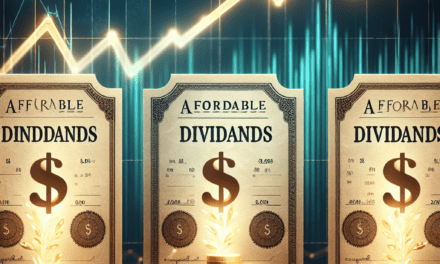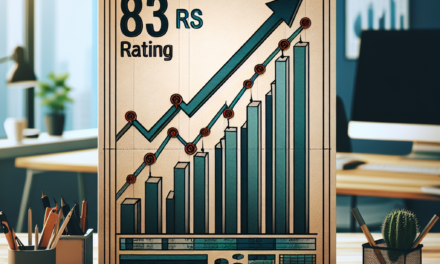“Securing the Golden Years: Top 9 Stocks and ETFs Fueling a $48,000 Dividend Dream”
Introduction
As a 53-year-old preparing for retirement, building a robust dividend income portfolio is a strategic move to ensure financial stability and passive income during the golden years. With an impressive annual dividend income of $48,000, this individual has carefully curated a selection of top-performing stocks and ETFs to maximize returns and minimize risk. This portfolio is designed to provide consistent income while capitalizing on growth opportunities, reflecting a balanced approach to retirement planning. Here are the top nine stocks and ETFs that form the cornerstone of this dividend-focused investment strategy, each chosen for their strong track record, reliable payouts, and potential for future appreciation.
Understanding Dividend Income: A Guide for Aspiring Retirees
As individuals approach retirement, the prospect of generating a steady income stream becomes increasingly important. For many, dividend income represents a viable solution to supplement retirement savings. This is particularly true for those who have diligently invested over the years, like the 53-year-old investor who is currently earning $48,000 annually from dividends. Understanding how to build a portfolio that generates such income is crucial for aspiring retirees. By examining the top nine stocks and ETFs in this investor’s portfolio, we can gain insights into effective strategies for achieving similar financial goals.
To begin with, dividend income is derived from the profits that companies distribute to their shareholders. This form of income can provide a reliable cash flow, especially when reinvested over time to compound growth. The investor in question has strategically selected a mix of individual stocks and exchange-traded funds (ETFs) to optimize their dividend returns. This diversified approach not only mitigates risk but also capitalizes on various sectors of the economy.
Among the top stocks in this portfolio are well-established companies known for their consistent dividend payouts. These include blue-chip stocks, which are typically large, financially sound companies with a history of reliable performance. Investing in such companies can offer stability and predictability, essential qualities for those nearing retirement. Furthermore, these stocks often have a track record of increasing dividends over time, which can help combat inflation and maintain purchasing power.
In addition to individual stocks, the inclusion of ETFs provides further diversification. ETFs are investment funds that hold a collection of assets, such as stocks or bonds, and are traded on stock exchanges. They offer the advantage of broad market exposure and can be tailored to focus on dividend-paying companies. By incorporating ETFs into the portfolio, the investor can benefit from the collective strength of multiple companies, reducing the impact of any single company’s performance on overall returns.
Transitioning to the specific selections within the portfolio, it is important to note the balance between high-yield and growth-oriented investments. High-yield stocks and ETFs provide immediate income, which is attractive for those looking to retire soon. However, growth-oriented investments, while potentially offering lower initial yields, can lead to significant capital appreciation and increased dividend payouts in the future. This balance ensures that the portfolio not only meets current income needs but also has the potential for long-term growth.
Moreover, the investor’s strategy includes regular portfolio reviews and adjustments. This proactive approach allows for the reallocation of assets in response to market changes or shifts in personal financial goals. By staying informed and adaptable, the investor can maintain a portfolio that aligns with their retirement objectives.
In conclusion, building a portfolio that generates substantial dividend income requires careful planning and a strategic mix of investments. By focusing on a combination of reliable dividend-paying stocks and diversified ETFs, aspiring retirees can create a sustainable income stream. The experience of the 53-year-old investor serves as a valuable example for those looking to achieve financial independence in retirement. Through disciplined investing and ongoing portfolio management, it is possible to enjoy the benefits of dividend income and secure a comfortable retirement.
Building a Retirement Portfolio: Key Strategies for Success
As individuals approach retirement, the focus often shifts from accumulating wealth to generating a steady income stream that can sustain their lifestyle in the absence of a regular paycheck. For a 53-year-old investor preparing to retire, earning $48,000 annually in dividend income is a testament to the power of strategic portfolio construction. This investor’s approach offers valuable insights into building a retirement portfolio that balances growth and income, ensuring financial security in the golden years.
To achieve such a substantial dividend income, the investor has carefully selected a mix of individual stocks and exchange-traded funds (ETFs) that provide both stability and growth potential. The portfolio’s composition reflects a diversified strategy, which is crucial in mitigating risks associated with market volatility. By spreading investments across various sectors and asset classes, the investor reduces the impact of any single economic downturn on their overall financial health.
One of the key strategies employed in this portfolio is the inclusion of dividend aristocrats—companies with a long history of consistently increasing their dividend payouts. These stocks are often found in sectors such as consumer goods, healthcare, and utilities, which tend to be more resilient during economic fluctuations. By investing in companies with a proven track record of dividend growth, the investor ensures a reliable income stream that can keep pace with inflation over time.
In addition to individual stocks, the portfolio includes several ETFs that focus on high-yield dividends. These funds offer the advantage of diversification within a single investment vehicle, reducing the need for constant monitoring and rebalancing. Moreover, ETFs often have lower expense ratios compared to mutual funds, making them a cost-effective choice for income-focused investors. By selecting ETFs that target different sectors and regions, the investor further enhances the portfolio’s resilience and growth potential.
Another important aspect of this retirement portfolio is the emphasis on quality over quantity. Rather than chasing high yields indiscriminately, the investor prioritizes companies with strong fundamentals, such as solid cash flow, manageable debt levels, and a commitment to returning value to shareholders. This approach minimizes the risk of dividend cuts, which can significantly impact income stability during retirement.
Furthermore, the investor remains mindful of tax implications, as dividend income can be subject to varying tax rates depending on the jurisdiction and the type of account in which the investments are held. By strategically placing high-yield investments in tax-advantaged accounts, such as IRAs or 401(k)s, the investor can maximize after-tax income and preserve more wealth for retirement.
In conclusion, building a retirement portfolio that generates substantial dividend income requires a thoughtful and disciplined approach. By focusing on diversification, quality investments, and tax efficiency, this 53-year-old investor has created a robust financial foundation for retirement. As others look to emulate this success, it is essential to tailor investment strategies to individual goals, risk tolerance, and time horizons. With careful planning and execution, achieving a comfortable and secure retirement is within reach for those willing to invest the time and effort into constructing a well-balanced portfolio.
Top Stocks for Reliable Dividend Income in 2023
As individuals approach retirement, securing a stable income stream becomes a paramount concern. For a 53-year-old investor preparing to retire, generating $48,000 annually from dividend income is a testament to strategic financial planning and disciplined investing. This investor’s portfolio, comprising a mix of individual stocks and exchange-traded funds (ETFs), highlights the importance of selecting reliable dividend-paying assets. In 2023, certain stocks and ETFs stand out for their ability to provide consistent and robust dividend income, making them attractive options for those seeking financial security in their retirement years.
To begin with, dividend aristocrats, companies that have consistently increased their dividends for at least 25 consecutive years, form the backbone of this portfolio. These companies are renowned for their financial stability and commitment to returning capital to shareholders. Among them, Johnson & Johnson, a healthcare giant, offers a blend of growth and income with its strong dividend history and diversified business model. Similarly, Procter & Gamble, a leader in consumer goods, provides a reliable income stream, supported by its extensive product portfolio and global reach.
In addition to individual stocks, ETFs play a crucial role in this portfolio by offering diversification and reducing risk. The Vanguard Dividend Appreciation ETF is a prime example, focusing on companies with a history of increasing dividends. This ETF provides exposure to a broad range of sectors, ensuring that the investor is not overly reliant on any single industry. Furthermore, the Schwab U.S. Dividend Equity ETF is another excellent choice, known for its low expense ratio and focus on high-quality U.S. companies with strong dividend yields.
Transitioning to the energy sector, Chevron stands out as a top pick due to its robust dividend yield and strong cash flow generation. The company’s strategic investments in renewable energy also position it well for future growth, making it a compelling choice for income-focused investors. Similarly, in the utilities sector, NextEra Energy offers a combination of steady dividends and growth potential, driven by its leadership in renewable energy projects.
Moreover, the financial sector provides additional opportunities for dividend income. JPMorgan Chase, a leading global financial institution, is known for its solid dividend payments and strong balance sheet. Its diversified business operations and prudent risk management make it a reliable choice for those seeking income stability. Additionally, the iShares Select Dividend ETF offers exposure to a wide array of high-dividend-paying U.S. companies, further enhancing the portfolio’s income potential.
Finally, the inclusion of real estate investment trusts (REITs) adds another layer of diversification and income generation. Realty Income Corporation, often referred to as “The Monthly Dividend Company,” is renowned for its consistent monthly dividend payments and high occupancy rates across its properties. This makes it an attractive option for investors looking to supplement their income with real estate exposure.
In conclusion, constructing a portfolio that generates substantial dividend income requires careful selection of stocks and ETFs that offer both reliability and growth potential. By focusing on dividend aristocrats, sector leaders, and diversified ETFs, this 53-year-old investor has successfully built a portfolio that not only meets current income needs but also provides a solid foundation for future financial security. As retirement approaches, maintaining a well-balanced and diversified portfolio remains essential to ensuring a stable and sustainable income stream.
ETFs vs. Individual Stocks: Which is Better for Dividend Investors?

When considering the optimal strategy for generating dividend income, investors often face the decision between investing in individual stocks or exchange-traded funds (ETFs). Each option presents distinct advantages and potential drawbacks, making the choice largely dependent on an investor’s financial goals, risk tolerance, and investment knowledge. For a 53-year-old investor preparing for retirement and currently earning $48,000 in dividend income, understanding the nuances of these investment vehicles is crucial.
Individual stocks offer the potential for higher dividend yields and capital appreciation. By selecting specific companies with a strong track record of dividend payments, investors can tailor their portfolios to align with their income objectives. This approach allows for greater control over investment choices, enabling investors to focus on companies with robust financial health, consistent earnings growth, and a commitment to returning capital to shareholders. However, investing in individual stocks requires thorough research and a deep understanding of market dynamics. The risk of company-specific issues, such as declining revenues or management changes, can significantly impact dividend payments and stock prices, potentially jeopardizing the investor’s income stream.
In contrast, ETFs provide a diversified approach to dividend investing, offering exposure to a broad range of companies within a single investment. This diversification reduces the risk associated with individual stock selection, as the performance of the ETF is not reliant on the success of a single company. ETFs are particularly appealing to investors seeking a more hands-off approach, as they are managed by professionals who select and rebalance the underlying assets. Additionally, ETFs often have lower expense ratios compared to mutual funds, making them a cost-effective option for building a diversified portfolio. However, the trade-off for this diversification is typically a lower dividend yield compared to a carefully curated portfolio of individual stocks.
For the investor in question, who is nearing retirement and relies on a substantial dividend income, a balanced approach may be the most prudent strategy. By combining individual stocks with ETFs, the investor can benefit from the high yields of select companies while mitigating risk through diversification. This hybrid strategy allows for the flexibility to adjust the portfolio as market conditions change, ensuring a steady income stream throughout retirement.
When selecting individual stocks, the investor might focus on companies with a history of increasing dividends, such as those in the utilities, consumer staples, and healthcare sectors. These industries are known for their stability and resilience, even during economic downturns. On the other hand, ETFs that track dividend-focused indices, such as the S&P 500 Dividend Aristocrats or the Vanguard High Dividend Yield ETF, can provide broad exposure to high-quality dividend-paying companies.
Ultimately, the decision between individual stocks and ETFs depends on the investor’s personal preferences and financial situation. Those with the time and expertise to research and monitor individual companies may prefer the potential rewards of stock selection. Conversely, investors seeking simplicity and reduced risk may find ETFs to be a more suitable choice. By carefully considering the benefits and limitations of each option, dividend investors can construct a portfolio that aligns with their retirement goals and provides a reliable source of income.
How to Maximize Your Dividend Income Before Retirement
As individuals approach retirement, the focus often shifts from accumulating wealth to generating a steady income stream that can sustain their lifestyle in the absence of a regular paycheck. For a 53-year-old investor preparing for retirement, earning $48,000 annually in dividend income is a testament to the power of strategic investment choices. This investor’s portfolio, comprising a mix of stocks and exchange-traded funds (ETFs), serves as a valuable case study for those looking to maximize their dividend income before retirement.
To begin with, the foundation of a robust dividend portfolio lies in selecting companies with a strong track record of paying and increasing dividends. This investor has wisely chosen to include blue-chip stocks, which are renowned for their stability and consistent dividend payouts. Companies such as Johnson & Johnson and Procter & Gamble are often favored for their resilience in various economic climates and their commitment to returning capital to shareholders. By investing in such stalwarts, one can ensure a reliable income stream that is less susceptible to market volatility.
In addition to individual stocks, this investor has diversified their portfolio with dividend-focused ETFs. These funds offer exposure to a broad range of dividend-paying companies, thereby reducing the risk associated with holding individual stocks. For instance, the Vanguard Dividend Appreciation ETF is a popular choice among income-focused investors, as it targets companies with a history of increasing dividends over time. By incorporating ETFs, the investor not only benefits from diversification but also from the expertise of fund managers who meticulously select high-quality dividend stocks.
Moreover, the importance of sector diversification cannot be overstated when constructing a dividend portfolio. This investor has allocated funds across various sectors, including healthcare, consumer staples, and utilities, each of which offers unique advantages. Healthcare companies, for example, often provide robust dividends due to the sector’s essential nature and consistent demand. Meanwhile, consumer staples are known for their defensive characteristics, making them a reliable source of income during economic downturns. Utilities, with their regulated business models, offer predictable cash flows, which translate into stable dividends.
Furthermore, the investor has strategically reinvested dividends over the years, allowing the power of compounding to enhance their income potential. Reinvesting dividends can significantly boost the growth of a portfolio, as it enables the purchase of additional shares, which in turn generate more dividends. This cycle of reinvestment can lead to exponential growth in income, particularly when started early in one’s investment journey.
As retirement approaches, it is also crucial to periodically review and adjust the portfolio to align with changing financial goals and risk tolerance. This investor has demonstrated prudence by regularly assessing the performance of their holdings and making necessary adjustments. For instance, trimming positions in overvalued stocks or reallocating funds to higher-yielding opportunities can optimize income generation.
In conclusion, maximizing dividend income before retirement requires a thoughtful approach that balances stability, growth, and diversification. By selecting a mix of reliable dividend stocks and ETFs, diversifying across sectors, reinvesting dividends, and regularly reviewing the portfolio, investors can build a sustainable income stream that supports their retirement goals. This 53-year-old’s success in generating $48,000 in annual dividend income serves as an inspiring example for those on the cusp of retirement, illustrating the potential of a well-crafted dividend strategy.
The Role of Dividend Reinvestment in Growing Your Portfolio
Dividend reinvestment plays a pivotal role in the growth of an investment portfolio, particularly for those nearing retirement, like the 53-year-old investor earning $48,000 annually in dividend income. This strategy involves using dividends received from stocks or exchange-traded funds (ETFs) to purchase additional shares, thereby compounding returns over time. As dividends are reinvested, the investor acquires more shares, which in turn generate more dividends, creating a virtuous cycle of growth. This approach can significantly enhance the value of a portfolio, especially when implemented consistently over the years.
For investors preparing for retirement, dividend reinvestment offers a reliable method to increase their income streams without the need for additional capital. By reinvesting dividends, they can leverage the power of compounding, which Albert Einstein famously referred to as the “eighth wonder of the world.” This compounding effect is particularly beneficial in a low-interest-rate environment, where traditional savings accounts and bonds may not provide sufficient returns to outpace inflation. Consequently, dividend reinvestment becomes an attractive option for those seeking to bolster their retirement savings.
Moreover, dividend reinvestment can help mitigate the impact of market volatility. During periods of market downturns, reinvested dividends allow investors to purchase shares at lower prices, effectively reducing the average cost per share. This strategy, known as dollar-cost averaging, can enhance long-term returns by capitalizing on market fluctuations. As a result, investors who consistently reinvest dividends are better positioned to weather market turbulence and achieve their financial goals.
In the context of the 53-year-old investor’s portfolio, which includes a mix of nine top-performing stocks and ETFs, dividend reinvestment can be a crucial component of their retirement strategy. By carefully selecting dividend-paying assets with a history of stable and growing payouts, the investor can ensure a steady stream of income that can be reinvested to further compound growth. Companies with strong fundamentals and a commitment to returning capital to shareholders are ideal candidates for such a portfolio.
Furthermore, the inclusion of ETFs in the portfolio provides diversification benefits, reducing the risk associated with individual stock investments. ETFs often hold a basket of dividend-paying stocks, offering exposure to various sectors and industries. This diversification can enhance the stability of dividend income, as it is less reliant on the performance of a single company. By reinvesting dividends from both individual stocks and ETFs, the investor can optimize their portfolio’s growth potential while maintaining a balanced risk profile.
As retirement approaches, the investor may choose to gradually shift their focus from reinvestment to income generation. At this stage, the accumulated shares from years of reinvestment can provide a substantial income stream, supplementing other retirement savings. This transition underscores the importance of dividend reinvestment in building a robust financial foundation for retirement.
In conclusion, dividend reinvestment is a powerful tool for growing an investment portfolio, particularly for those nearing retirement. By harnessing the power of compounding, mitigating market volatility, and ensuring diversification, investors can significantly enhance their financial security. For the 53-year-old investor earning $48,000 in dividend income, reinvesting dividends from their top nine stocks and ETFs can play a crucial role in achieving a comfortable and financially stable retirement.
Analyzing Risk: Balancing Growth and Stability in Dividend Investing
In the realm of dividend investing, balancing growth and stability is a crucial consideration, particularly for individuals approaching retirement. For a 53-year-old investor earning $48,000 annually in dividend income, the challenge lies in maintaining a portfolio that not only provides consistent income but also offers potential for growth. This delicate balance is essential to ensure that the portfolio can withstand market fluctuations while continuing to meet income needs. The investor’s portfolio, comprising a mix of nine stocks and ETFs, serves as a testament to the strategic approach required to achieve this balance.
To begin with, the inclusion of dividend-paying stocks in the portfolio is a fundamental strategy for generating steady income. Companies with a history of reliable dividend payments, such as those in the utilities and consumer staples sectors, often provide a stable income stream. These sectors are known for their resilience during economic downturns, as they offer essential goods and services that remain in demand regardless of market conditions. By investing in such companies, the investor can secure a foundation of stability within the portfolio.
However, stability alone is not sufficient for long-term success. Growth is equally important, particularly in the face of inflation and rising living costs. To address this, the investor has incorporated growth-oriented stocks and ETFs into the portfolio. These investments, often found in sectors like technology and healthcare, offer the potential for capital appreciation. While they may carry higher volatility, their inclusion is vital for enhancing the portfolio’s overall growth prospects. By carefully selecting growth stocks with strong fundamentals and promising future prospects, the investor can achieve a balanced approach that mitigates risk while pursuing growth.
Moreover, diversification plays a pivotal role in managing risk within the portfolio. By spreading investments across various sectors and asset classes, the investor can reduce the impact of any single market event on the overall portfolio. This strategy not only enhances stability but also provides exposure to different growth opportunities. For instance, the inclusion of ETFs allows for diversification within a single investment, offering access to a broad range of companies and industries. This diversification is particularly beneficial in volatile markets, where certain sectors may outperform others.
In addition to diversification, regular portfolio review and rebalancing are essential practices for maintaining the desired balance between growth and stability. As market conditions change, certain investments may no longer align with the investor’s objectives. By periodically assessing the portfolio’s performance and making necessary adjustments, the investor can ensure that the portfolio remains aligned with their retirement goals. This proactive approach allows for the timely identification of underperforming assets and the reallocation of resources to more promising opportunities.
Furthermore, understanding the tax implications of dividend income is crucial for optimizing the portfolio’s performance. Different types of dividends may be subject to varying tax rates, and strategic tax planning can enhance the investor’s net income. By consulting with a financial advisor or tax professional, the investor can explore tax-efficient strategies, such as holding dividend-paying stocks in tax-advantaged accounts, to maximize after-tax returns.
In conclusion, achieving a balance between growth and stability in dividend investing requires a multifaceted approach. By carefully selecting a mix of stable and growth-oriented investments, diversifying across sectors, regularly reviewing the portfolio, and considering tax implications, the investor can build a resilient portfolio that supports their retirement goals. This strategic approach not only ensures a steady income stream but also positions the portfolio for long-term growth, providing peace of mind as the investor transitions into retirement.
Q&A
1. **Question:** What is the primary goal of the 53-year-old individual in the context of their investment strategy?
– **Answer:** The primary goal is to prepare for retirement by generating a steady income through dividends.
2. **Question:** How much annual income does the individual earn from dividends?
– **Answer:** The individual earns $48,000 annually from dividends.
3. **Question:** What is the significance of the dividend income for the individual?
– **Answer:** The dividend income provides a reliable source of cash flow to support their lifestyle in retirement.
4. **Question:** How many stocks and ETFs are included in the individual’s portfolio?
– **Answer:** The portfolio consists of 9 stocks and ETFs.
5. **Question:** What is the investment strategy employed by the individual to achieve their retirement goals?
– **Answer:** The strategy involves investing in a diversified portfolio of dividend-paying stocks and ETFs to ensure consistent income.
6. **Question:** Why might the individual choose to invest in both stocks and ETFs?
– **Answer:** Investing in both stocks and ETFs allows for diversification, reducing risk while maintaining a steady income stream.
7. **Question:** What is a potential benefit of focusing on dividend income for retirement planning?
– **Answer:** Focusing on dividend income can provide a predictable and potentially growing income stream, which is beneficial for covering expenses in retirement.
Conclusion
The 53-year-old individual preparing for retirement with an annual dividend income of $48,000 has strategically built a diversified portfolio comprising top-performing stocks and ETFs. This approach not only provides a steady income stream but also mitigates risk through diversification. The focus on high-quality dividend-paying assets suggests a well-thought-out strategy aimed at ensuring financial stability and growth as they transition into retirement. By selecting a mix of reliable dividend stocks and ETFs, the individual is positioned to benefit from both capital appreciation and consistent income, aligning with long-term retirement goals.





